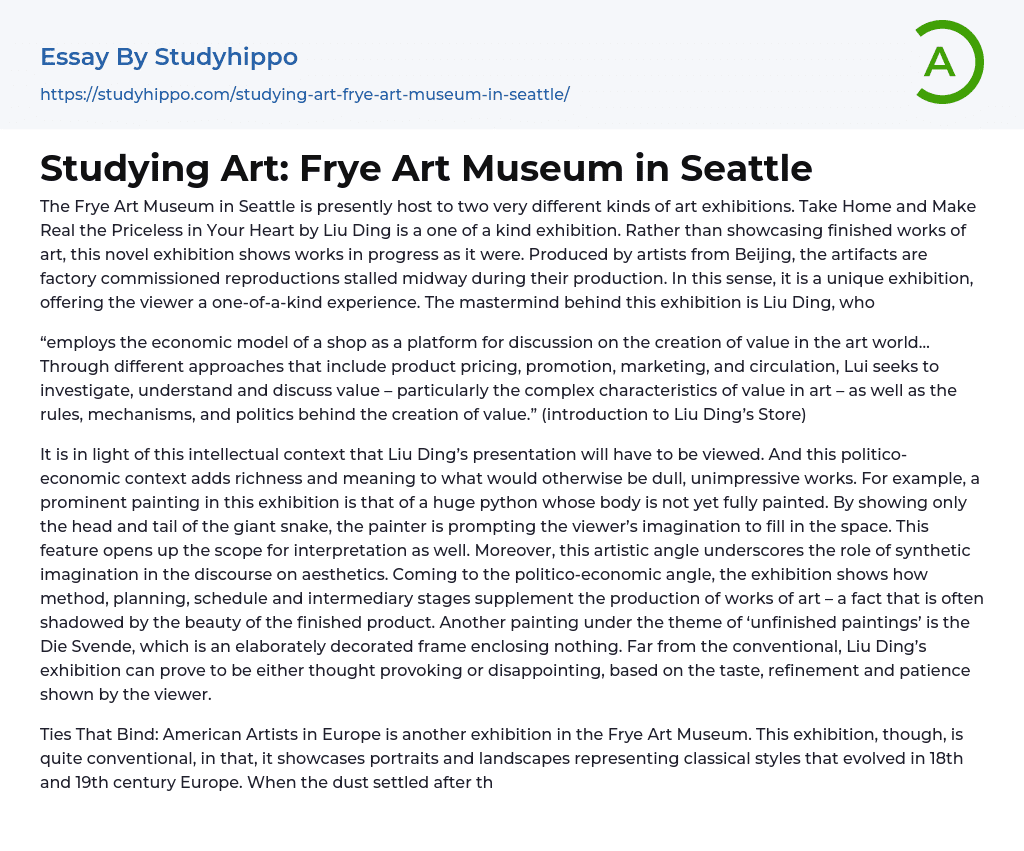The current exhibitions at the Frye Art Museum in Seattle offer two distinct types of art. One of them is Liu Ding's exhibition titled "Take Home and Make Real the Priceless in Your Heart," which stands out for its unconventional approach. Unlike traditional exhibitions, it showcases works that are still in progress. These works are reproductions commissioned by a factory in Beijing, but they have been intentionally halted during their production. This creates a truly unique experience for viewers, as they get to see the evolution of the artwork firsthand. Liu Ding is the brilliant mind behind this exceptional exhibition.
"Liu Ding's Store" employs a shop's economic model as a platform to discuss the creation of value in the art world. By exploring product pricing, promotion, marketing, and circulation, Liu investigates and comprehends value, particularly the intricate qualities in art. Additionally, he delves into the rules, m
...echanisms, and politics that shape the creation of value.
Liu Ding’s presentation should be viewed within the intellectual and politico-economic context described above. These contexts add depth and significance to what may otherwise be perceived as mundane and unimpressive artwork. For instance, one prominent painting featured in the exhibition depicts a large python with only its head and tail painted, leaving the body incomplete. This intentional omission invites viewers to use their imagination to fill in the missing portion and allows for diverse interpretations. Additionally, this artistic approach emphasizes the significance of synthetic imagination in discussions of aesthetics. The exhibition also highlights the politico-economic aspect by illustrating how the process of creating artworks, including methods, planning, schedules, and intermediary stages, often goes unnoticed amidst the allure of the finished product. Anothe
painting, titled "Die Svende," features an ornate frame containing nothing, challenging conventions of traditional art. Liu Ding's exhibition is unconventional and has the potential to evoke either thoughtfulness or disappointment, depending on the viewer's taste, refinement, and patience.
The Frye Art Museum is currently hosting an exhibition titled Ties That Bind: American Artists in Europe. This exhibition focuses on showcasing portraits and landscapes created by American artists who were influenced by classical European styles from the 18th and 19th centuries. After the Civil War in 1865, many American artists traveled to Europe to fully immerse themselves in its thriving artistic culture. In Europe, there was a flourishing period of artistic, cultural, and intellectual expression that attracted these American artists who wanted to be part of this stimulating environment. Consequently, a significant era of artistic production emerged as American talents adapted European techniques and traditions into their own works.
One of the paintings on display is William Merritt Chase’s Portrait of a Lady against Pink Ground (ca.1886). Chase divulged that each sitter he painted presented a new aspect of their personality, providing constant variety and study in his work. The portrait captures the bohemian attitude through the lady’s pose and posture, portraying Miss Virginia Gerson.
John Singer Sargent’s Mrs. Frederick William Roller (dated 1895) shares a similar theme as it adapts a mature style of portraiture, capturing the interior life of the sitter against finely articulated backdrops. Mrs. Roller, an elderly lady dressed in black, stands within an architectural frame, creating a strong impact on the viewer. Sargent skillfully depicts the curves of her dress and pays great attention to detail in the room setting. The minimal use
of jewelry and accessories further showcases Sargent’s artistic effectiveness.
Another intimate portrait is Maybelle (1898) by Thomas Eakins. This close-range drawing reveals Eakins’ ability to imbue his sitter with inner spirit while showcasing her emotional and cerebral intelligence. The focused gaze of the sitter serves as further evidence of her strength of character.
Another genre represented in the exhibition is landscape paintings. One notable example is Albert Bierstadt’s rainbow in the Sierra Nevada (ca. 1871-73), which portrays a romanticized western landscape as an American Eden, as stated in the accompanying note. The beauty of the lake, mountain, and woods is enhanced by Bierstadt’s use of inner light. This painting goes beyond simply imitating life; it elevates perception to a higher level.
The Deserted Camp by Henry Raschen exhibits the grim truth of the organized removal and annihilation of Native Americans by settlers. The painting depicts the haunting but vibrant hues of the American West. In comparison, William Merritt Chase's Coast of Holland shares a similar theme with The Deserted Camp, but distinguishes itself by its ecological and geological aspects.
Frederick Childe Hassam’s Parc Monceau, Paris (1897) depicts the essence of leisure in Paris, with an aristocratic lady and child immersed in the garden's beauty. It serves as a metaphor for city life. Willard Leroy Metcalf’s Bank of the Seine (1888) has a haunting quality that lingers in one's memory, evoking melancholy and stagnancy. The painting incorporates characteristic features of the impressionist style. Lastly, John Henry Twachtman’s Windmills, Dardrecht (ca.1881) presents an elegant landscape.
- Design essays
- Graffiti essays
- Graphic essays
- Typography essays
- Painting essays
- Photography essays
- Sculpture essays
- Architecture essays
- Interior design essays
- Arch essays
- Area essays
- Aesthetics essays
- Art History essays
- Artist essays
- ballet essays
- Body Art essays
- Color essays
- Concert Review essays
- Creativity essays
- Cultural Anthropology essays
- Ethnography essays
- Harlem Renaissance essays
- Heritage essays
- Modernism essays
- Mona Lisa essays
- Pastoral essays
- Postmodernism essays
- Realism essays
- Symbolism essays
- Theatre essays
- Visual Arts essays
- Voice essays
- Work of art essays
- Academia essays
- Academic And Career Goals essays
- Academic Integrity essays
- Brainstorming essays
- Brown V Board of Education essays
- Brown Vs Board Of Education essays
- Coursework essays
- Curriculum essays
- Distance learning essays
- Early Childhood Education essays
- Education System essays
- Educational Goals essays
- First Day of School essays
- Higher Education essays
- Importance Of College Education essays
- Importance of Education essays
- Language Learning essays




